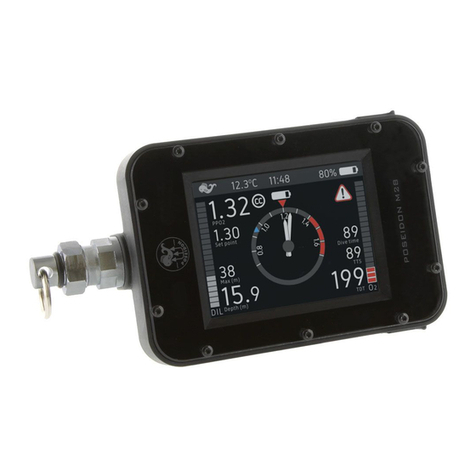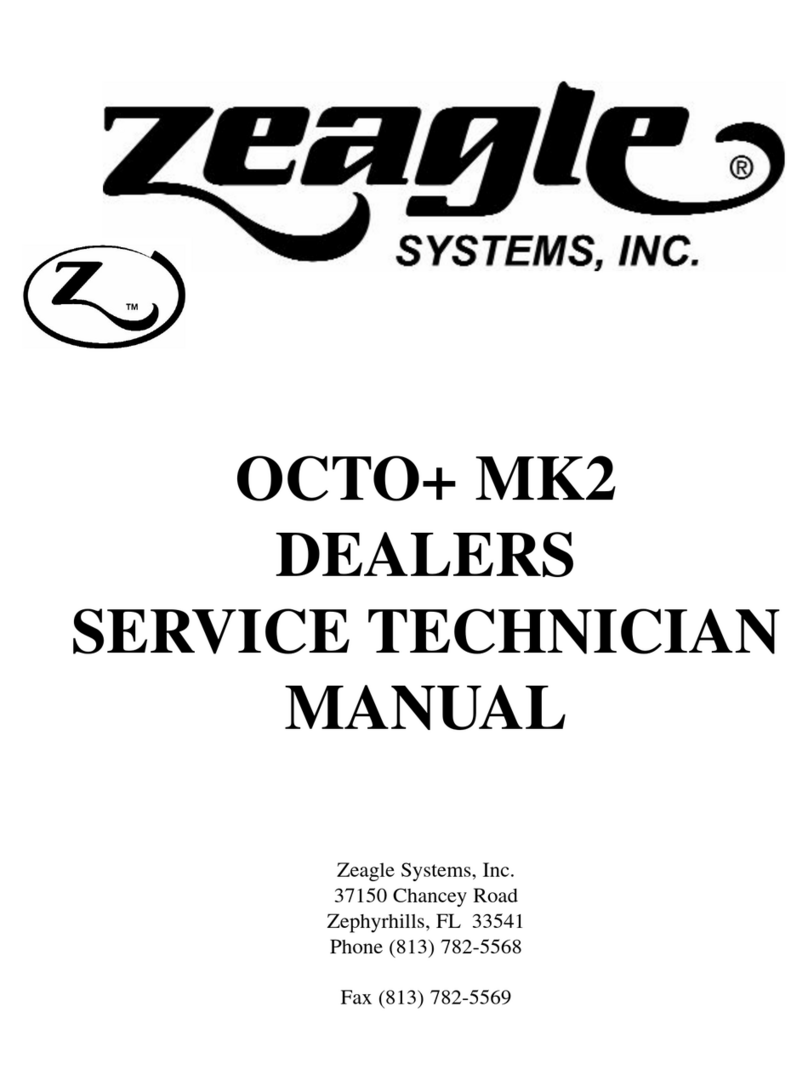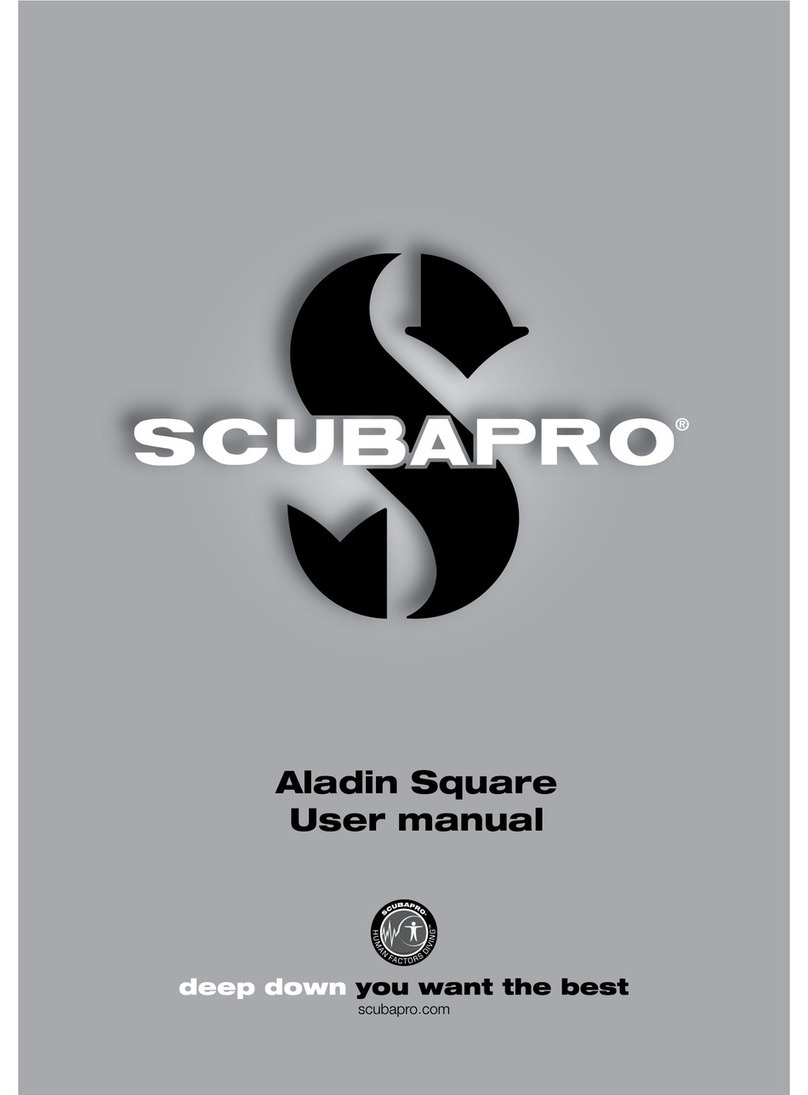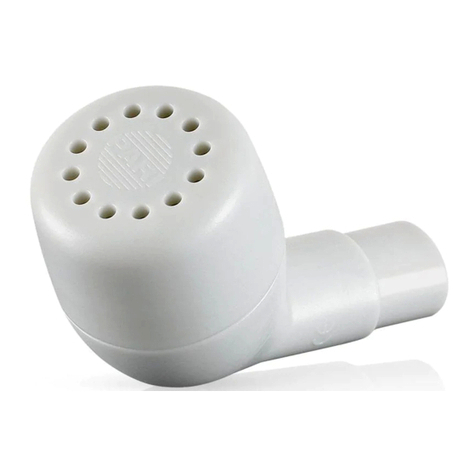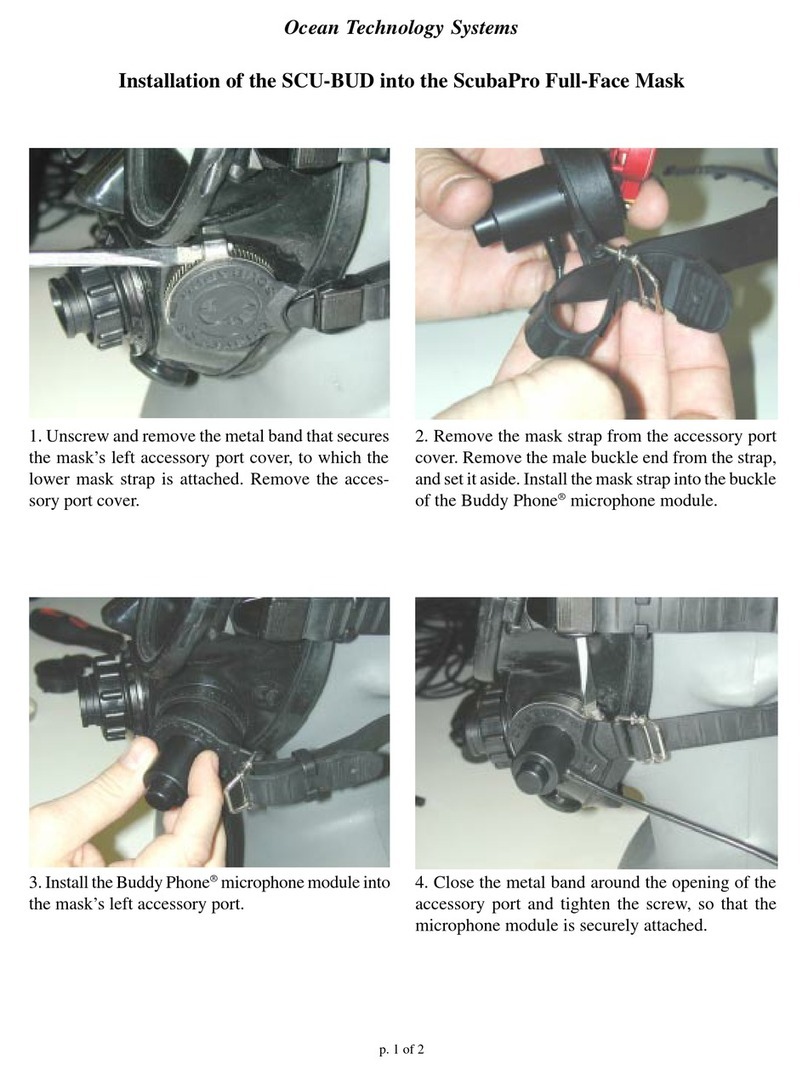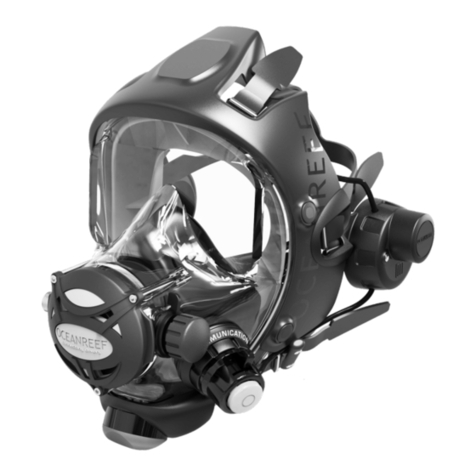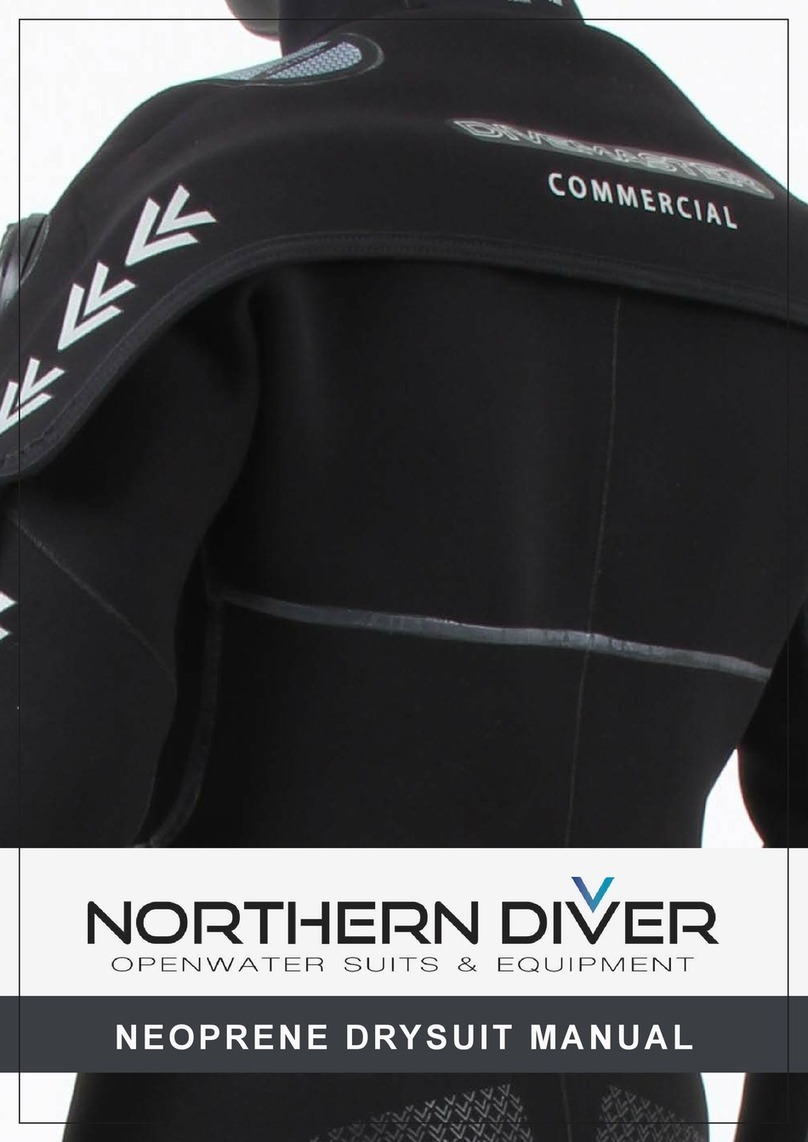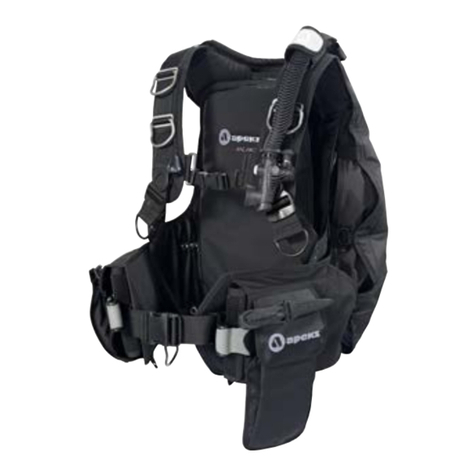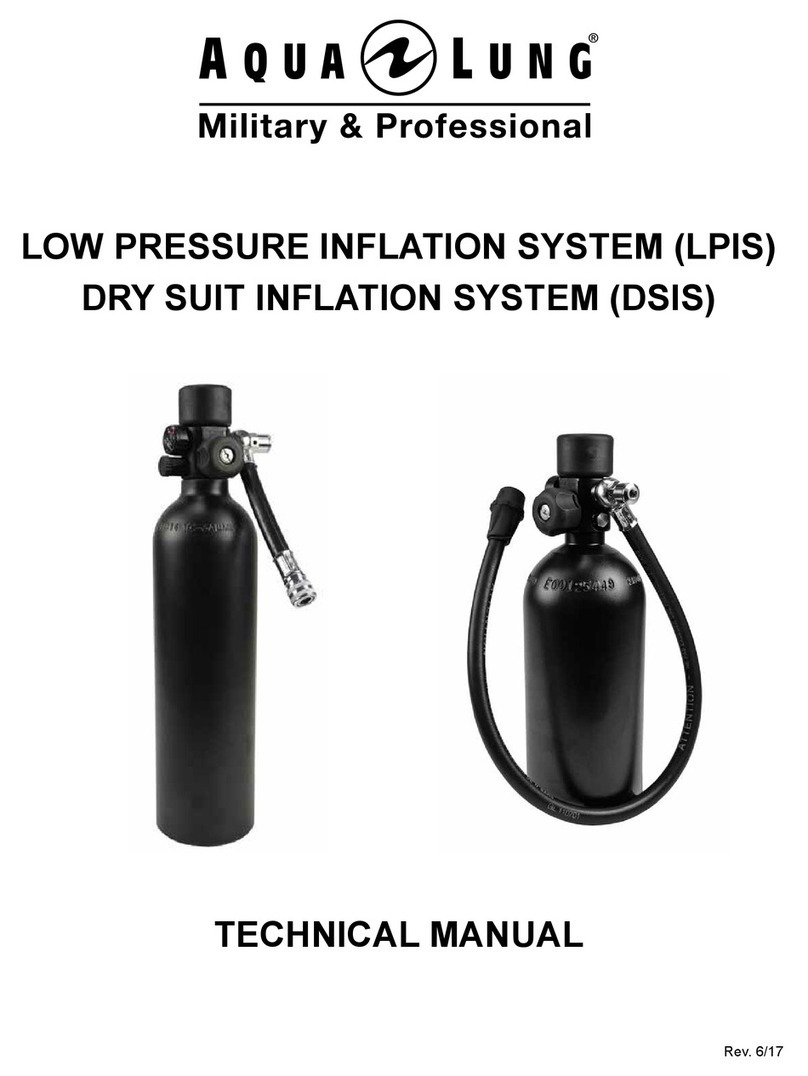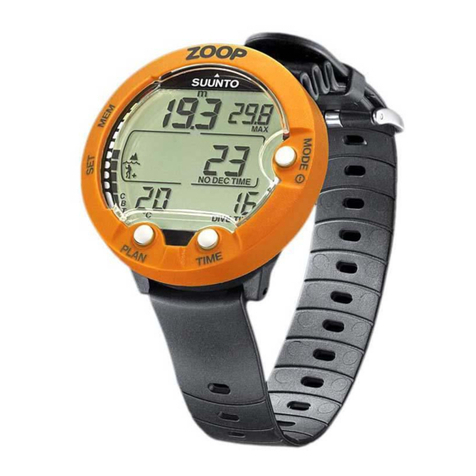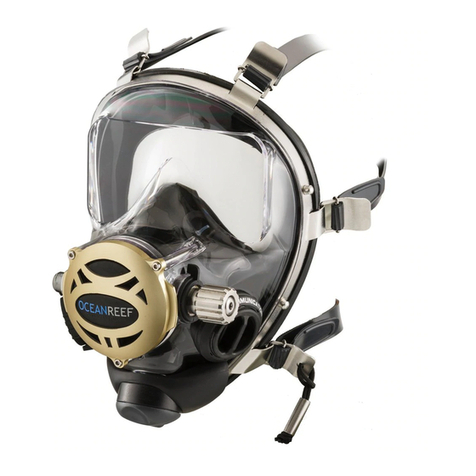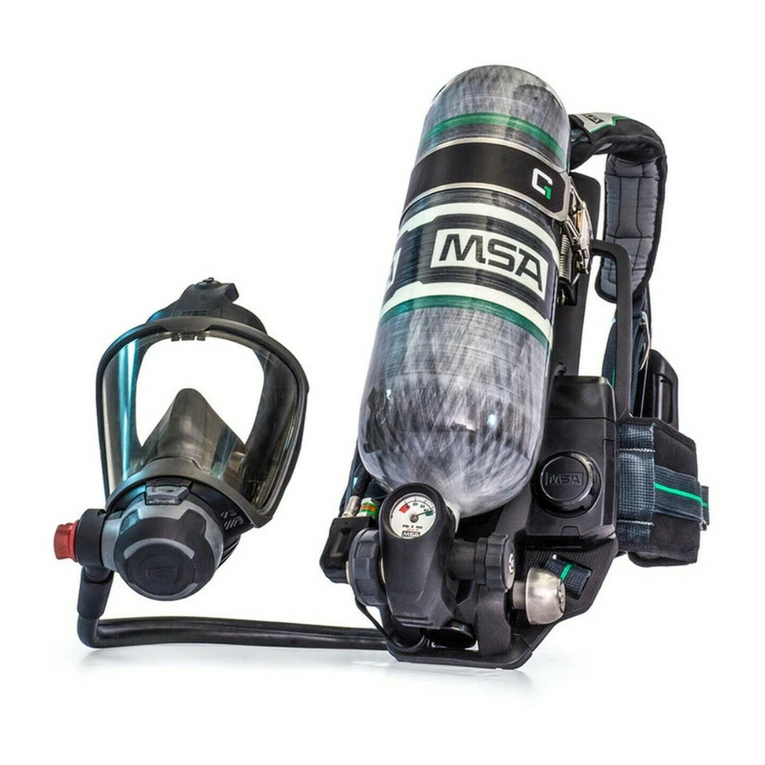TIR space 40 User manual


Recreational underwater diving represents a manner
of aggregation and, once in water, deserves great
emotions but, to live such intense moments, the
diver has to face up not little uneasiness, but being
able to remove two of the main negative factors,
diving could reserve very unforgettable moments.
A simple analysis put into evidence that
by drastically reducing weight and overall
dimensions of tanks and, during the dive,
drastically removing or reducing the typical
bubble noise of underwater breathing on
open circuit, we would be able to enjoy the
dive and appreciate the environment without
inconvenience.
Thanks to underwater breathing apparatus with
partial recycling of exhaled gas (SCR) semiclosed
circuit T.I.R./SPACE 40 (Tecnology Innovation
Rebreathing) we have reached the target; for instance,
with a tank of only 4,5 lt./0.16 cu. ft. weighting
about 5 kg./11 pounds, it is possible to make a dive
of more than 60 minuts at a depth of 30 mt./100 ft.,
even keeping 50 bars on the tank for unexpected
events; the logic consequence is a reduction of
bubbles (more then 90%) compared to a traditional
open circuit. In short, if at depth of 30 mt./100 ft. while using an open circuit about 80 lt./2.83
cu.ft. are exhaled every minute, with our underwater breathing apparatus these are reduced to
about 8 lt./0.28 cu.ft every minute; this way the
underwater environment is not affected by the
“intrusions” and so it is not “frightened”, certainly
a goal that could be considered fantastic.
With that in mind it is appropriate to know into
details the genesis of our underwater breathing
apparatus with partial recycling of exhaled gas,
which was wanted, planned and developed by
Claudio Beux, a professional diver who dived for
more than thirty years, usually down to more than
100 mt./334 ft.; being in difficulty due to very
heavy open circuit equipmets and even more with
semiclosed (SCR) or close (CCR) circuit breathing
apparatuses available, he had to invent for himself
a lighter underwater breathing apparatus that
could help a less tiring respiration, allowing him
to dive deeper than 100 mt./334 ft. without getting
breathless while swimming against sea current.

From 1992 to 2004
twelve years of tests
occurred, through
which Claudio Beux
made dozens of
craftmade prototypes
with several
modifications (see
photo); after over a
thousand dives down
to 140 mt./ 468 ft.
of depth with no
accident, he decided
to put on market the
underwater breathing
apparatus TIR/
SPACE 40.
After most important
and innovatory ideas had been patented in Europe, USA and Canada, a company started the
manufacturing of
several moulds
necessary for the
large production
of the various
components. It
was undoubtely
a heavy financial
investment, targeted
to obtain a more
competitive product
in comparison to
current underwater
breathing apparatus
on the market having
the same aims and
final employment
destination.
From 2005 Claudio
Beux has had the chance to use and perfectionate all the prototypes obtained by mass production
up to the final current version, which was already used in several hundred dives, all of them
done at more than 100 mt./334 ft of depth.
Successively, the producer had the chance to carry out a simpler recreational version called
SPACE 40, with the help of several instructors who did hundreds dives down to 40 mt./133 ft. of
depth and did not find any major problem; so the decision was taken to start mass production.
The obtained outcome seems even too easy to use and, like many of the most brilliant ideas, it
is the best you can find on the market in terms of safety, lightness, simplicity, functionality and
cost.

To list its strenght points, the SPACE 40 is:
- The safest. A transparent canister allows
to see if the filtered material is in perfect
conditions and if there are liquids into it; in
this case, with a very simple operation, it
is possible to eliminate them outside even
during the dive.
- The lightest. The standard version has a
total weight of only 8 kg./ 18 pounds (filter
and jacket included), while the version with
a tank of 4,5 lt./0.16 cu. ft weights only 13
kg./29 pounds.
- The simplest. In just a few seconds it is
possible to replace the filter; in just a few
seconds it can be washed inside without
dismantling it or using special tools; in case
of emergency it can be used as a traditional
open circuit. It is completely automatic and,
in case of need, the automatic supply can be
activated simply with the deep pressing of
the central membrane in the counterlung
like a big second stage.
- The most useful, with its front position at same level with lungs center of gravity, the
inhalation is supported by natural gas pushing up; therefore, during swimming phase,
gas supply will be no more “on request” as for a traditional rebreather or an open circuit
underwater breathing apparatus, but it will be “on offer” and sometimes it could resemble
the same pleasant sensation experienced while riding a motorcycle at speed of 50 km./62
miles per hour and breathing open-mouthed.
- The most competitive. The use of injection moulds for the manufacturing in mass production
has made possible a remarkable cost reduction, as well as the use of special materials like
strengthened technical polymers and special elastomers, all of them oxygen compatible,
light and very resistant. It is a product strictly and completely MADE in ITALY
In short, THE SIMPLEST AND SAFEST UNDERWATER BREATHING APPARATUS
SYSTEM TODAY ON THE MARKET WORLDWIDE, WITHOUT EQUIVALENT
ALTERNATIVES.
SEMI-CLOSED CIRCUIT FOR RECREATIONAL USE
NOTE:It is for sport or recreational use when it is restricted to the maximum depth of 40
meters/133 feet and the diving time do not necessitate decompression stops. In any case, before
the use of breathing apparatus, it is necessary to follow a specific course taken by qualified
instructors.
The action of underwater breathing apparatus TIR/SPACE 40 is undoubtedly different from
any other rebreather present on the worldwide market, as it has no internal bags and it does not
exhale through an overpressure valve but, like others, it partially recycles exhaled gas.
Exhaled gas flux is leaded into a sealed loop that forces it to pass through the filter; the filter
absorbs carbon dioxide produced by the organism during breathing, then it is reintroduced into
the counterlung and is breathed again.

In order to allow these phases it is essential
to enrich the used gas with oxygen to make it
possible to be breathed additional times. The
enrichment is provided by a constant flow
added to exhaled gas after this one is cleaned
by the filter; to make this possible only and
exclusively breathable mixes as Heliox
(Oxygen-Helium) or Nitrox can be used,
according to the depth reached; common air
cannot absolutely be used.
As we said, the channeled route of breathed
and exhaled gas is sealed; through a red
wrinkled hose it enters in a section that contains the exhaust valve linked to the counterlung
big membrane by a thin tube and it arrives to the big counterlung that lifts the exaust valve
membrane operating the opening during the phase of maximum expansion; this way the last part
of the exhaled gas –containing the maximum carbon dioxide concentration- is vented outside;
the exhaled gas staying in the loop enters the see-through container and then it goes into the
filter, where the filtering material chemically removes carbon dioxide. The flux of cleaned gas
goes into the counterlung and joins the continuous flow of mixture enriched with oxygen that
arrives from the tank through the injector and through the black wrinkled hose, it is breathed in
again and again for several times.
An agreeable collateral effect of these
subsequent cycles is the progressive rise in
temperature of the breathed gas that will not
make the diver notice water temperature,
even when it is cold.
Physicians claim that a diver’s oxygen
consumption can be an average of 1,5 lt. per
minute (1 lt. at rest and 2 lt. under pressure)
and that the oxygen partial pressure, resulting from the relation between the percentage of
oxygen in the breathable mixture and the ambient pressure, must be less than 1.4/ maximum1.5
bars; so the percentage of oxygen present in the breathed gas and the quantity of constant flux
(liters per minute) must be determined in advance according to the planned maximum depth
of the dive. In short, the greater the depth of the dive will be, the greater will be the ambient
pressure and consequently the smaller must be the percentage of oxygen present in the breathed
gas; in our case the considered values are as follow:
maximum depth 22 mt./ 73 ft. = 50% oxygen = flux 6/6,5 liters/minute (on request)
maximum depth 30 mt./100 ft. = 40% oxygen = flux 9/9,5 liters/minute (standard)
maximum depth 40 mt./133 ft. = 32% oxygen = flux 14/14,5 liters/minute (on request)
As an example:in the case of 30 mt./100 ft. of depth, with a mixture having the 40% of breathable
oxygen, the partial pressure will be: 0,40 (oxygen quantity) x 4ATA (ambient pressure) = 1.;, that is the
largest and the most critical value if breathed on open circuit, correct and normal if breathed
with a rebreather as it has not to be forgotten that after a few breathings the percentage of
oxygen in the counterlung can be even reduced of about 5% and this has to be considered also
for the dive time calculation.

To obtain the above values, underwater breathing apparatus TIR/SPACE 40 has a sealed
pressure reducer that reduces the tank pressure from 200 bars to steady 13 bars (as a rule, in
case of a sonic nozzle the intermediate pressure has to be at least double of foreseen pressure at
maximum depth + 20%); in our case the gas originated from the tank, at intermediate pressure
of 13 bars, passes through a sonic titanium nozzle with a calibrated opening that fixes a constant
flow of 9 lt./ (with the 40% of oxygen for the 30 mt./100ft.) or 14 lt (with the 32% of oxygen
for the 40 mt./133 ft.). In case of underwater breathing apparatus for professional use these
parametres will be very different but, in any
case, the flow of the mixture will always
assure a suitable and more than adequate
replacement of oxyigen at any depth.
The reference tecnical standards related
to the CE (European Standard) require
a breathing volume of 3 liters for closed
circuits (EN14143) or of 2,5 liters for
regulators in open circuit (EN250 and/or
EN13949). Underwater breathing apparatus
TIR/SPACE, the only one of its kind in
the world, has no internal bags like all the
other rebreathers on the market, but it has a counterlung with a membrane, which has a 2,5
liters volume and is more than sufficient to satisfy a normal breathing; if one or more very
deep breaths are necessary, for instance in case of breathlessness due to fatigue, a demand
larger than 2,5 liters will be fulfilled by the existing supply mechanics in the counterlung that
will automatically deliver the needed quantity of fresh mixture enriched with oxygen without
limitation and without effort, so that the diver will overcome immediately a possible critical
situation; likewise, the diver will be able to do the cleaning of the counterlung, whenever they
think it necessary, by simply exhaling from the nose or pushing on the center of the membrane.
It is obvious that in all these circumstances the supply mechanics operation will cause a larger
consumption and will penalize the foreseen endurance.
SEMICLOSED CIRCUIT FOR PROFESSIONAL USE
NOTE: we consider it for professional use when it is used under 40 mt./133 ft. and/or when
dives with decompression stops are planned at any depth.
This kind of diving needs wider and more complete knowledge and professionality, even using
Heliox mix too. Therefore it is not part of this informative report and of the normal use of underwater
breathing apparatus TIR/SPACE 40 configurated for recreational use as explained later.
For information we specify that the professional version keeps unchanged the counterlung
body and the technical features before indicated, while automatic mix of gas (Helium-Oxygen
or Helium-Nitrox) and fluxes are directly conditioned by water pressure – a system we have
patented also in USA and Canada. In short, two tanks are used, one containing Oxygen (or
Nitrox) and the other Helium, as well as two pressure reducers and two pertinent titanium sound
nozzles that automatically regulate flux management according to depth. For example, during
the immersion oxygen (or Nitrox) amount decreases and Helium (diluent) amount increases;
on the contrary, during the ascent while depth lowers oxygen (or Nitrox) amount increases and
Helium amount decreases; this way decompression is made possible breathing mixes enriched
with oxygen. Furthermore, in the last 12 meters under the water line(or 20 mt. when Nitrox is
used) the breathable mix is devoid of the diluent (Helium).

The user can choose the tank capacity (4-5-7-10 liters), not forgetting that a tank should be
used in open circuit in case of emergency (bail out); the capacity of this one must assure the
endurance, considering time of ascent with decompression stops to be complied in the worst
conditions. Users of a professional model can order an optional accessory to apply on the
wrinkled hose (black), to hold one or two cells of toxygen analyzers and the related partial
pressure. (see photo REB 5)
CLOSED CIRCUIT FOR PROFESSIONAL/MILITARY USE
(advanced A.R.O. - Oxygen underwater breathing apparatus)
Note: this version has been appropriately
studied and designed as closed circuit for
professional/military use down to a maximum
depth of 12 meters (ARO), then it would work
as semiclosed circuit (SCR) if diving to greater
depth is needed, but only with Helium/Oxygen
mix.
Underwater breathing apparatus TIR
configurated as advanced ARO is NON-
MAGNETIC and NOISELESS, it is provided
of two light alloy tanks with a capacity that can
vary from 3 to 8,80 pints (200 bars), pressure reducers are in TITANIUM as well the sonic;
filter endurance (120 minutes) can be doubled as necessary for operational needs.
Even if it keeps the same technical features of previous versions and the same automatism, this
special version called advanced ARO is a closed circuit down to 12 meters of maximum depth,
with possibility to descend to lower depth if necessary. In this case, it becomes a semiclosed
circuit when diving over 10/12 meters of depth, then it gets back to closed circuit version
(ARO) when on the way back to water line at a depth lower than 12 meters.
This configuration needs a specific training as use of pure oxygen is expected. So it is essential
that the user has been correctly instructed on potential dangers resulting from an incorrect use
of it, and for this reason we reserve to furnish more detailed and exhaustive information on this
topic during the theoretical and practical course taken by Claudio Beux; the frequency of our
course at the company site is compulsory and it will provide the necessary licence to use our
product.

SPACE 40 PERFORMANCES
The charts reproduced below show the performances
of our T.I.R./ SPACE 40 (complete with ExtendAir
filter and Heliox 30% mix that can be used down
to a maximum operational depth of 40 meters),
in accordance with reference to technical rules,
particularly chart A refers to EN 14143 rules as
required for closed circuit rebreathers that necessitate
a ventilation rate of 75 lpm; chart B refers to different
rules regulating open cicuit regulators that necessitate
a ventilation rate of 62,5 plm.
In chart A it is possible to see that the Space 40 stays
into the limits required and indicated on the graphic,
even at the depth of 42,3 meters;
In chart B it is possible to see that the Space 40 stays
into the limits required and indicated on the graphic,
even at the depth of 58,1 meters or more.
Even if it does not belong to the two categories cited
by the EN rules because of an innovative underwater
breathing apparatus with partial recycling of exhaled
gas that has not yet been ruled, through the graphics
it is possible to evict that the Space 40 performances exceed the required restrictive parameters for both
closed and open circuits.
We wish to thank the CressiSub for allowing the use of its facilities and its technical equipments
freely in more than an occasion.

USE OF RECREATIONAL UNDERWATER BREATHING
APPARATUS
Underwater breathing apparatus TIR/SPACE is delivered with
the following standard accessories:
1) An underwater breathing apparatus / counterlung;
2) A sealed pressure reducer;
3) Standard injector with TITANIUM sonic nozzle with measure
indicators, providing flow of 9,5 lt. for 40% of oxygen (as
optional for flow of 14/14,5 lt. for 32% of oxygen);
4) A complete Buoyancy Control Device with strengthened
technopolimer backholder, or as optional in stainless steel;
5) A standard analogic underwater gauge, or the AIR LIMIT
MONOMETER as optional;
6) A filter and its scrubber;
7) A set of straps to be used with a traditional BCD, or without it;
8) An user and maintenance guidebook;
9) A balanced alternate air source, Oxigen power-assisted model (as optional);
10) As optional, a 5 or 7lt. alluminium or steel tank, with twin valve Din 16 x 2 tube for Heliox/Nitrox.
A reference set of rules follows.

1) COUNTERLUNG
It is an essential component of underwater breathing apparatus made with a special stiffened
technical polymer; inside it the following parts are positioned:
a) a by-pass, an automatic gas supply mechanism;
b) a constant flux connection;
c) an exaust valve with the lever integral with the membrane through a thin tube;
d) a counterlung membrane with relative inner and outer spaces;
e) a canister;
f) a mouthpiece with wrinkled hoses;
g) connections for the hoses coming from the pressure reducer;
h) quick connections for the buoyancy device in the underbelt;
Note: we suggest periodical washing and check up of internal parts, in order to verify that there are no
signs of dirt, residuals of any kind, moulds or anything else that can pollute the clean flux crossing the
counterlung at each breath; moreover check that the one-way mouthpiece valves are intact and clean.
2) PRESSURE REDUCER
The pressure reducer is sealed for major safety. A piston placed inside
works while protected by two membranes and as it is not in contact
with the external environment, it is not polluted; it is connected to
the tank valves that have a Nitrox DIN 26x2 connection as required
by current regulations (if necessary only on individual request also
the DIN 25x2 or the reducing tube connection from 26x2 to 25x2
are available); it reduces tank pressure from 200/300 bars to 13/13,5
bars; it is furnished of 3 low pressure outlet 3/8 unf and 2 high
pressure outlet 7/16 unf appropriately signed HP.
Note: we suggest periodical testing of intermediate pressure (13 bars) using a normal air gauge
connected to the quick release hose of the Bouyancy Control Device (BCD).
3) SONIC NOZZLE INJECTOR
An intermediate constant 13,0 bars pressure, arriving from the pressure
reducer, passes through a titanium injector (sonic nozzle) and allows a
stable flux of 9/9,5 liters per minute when using Heliox or Nitrox 40% mix
for the maximum depth of 30 mt., or of 14/14,5 liters for minute when using
Heliox 32% mix for the maximum depth of 40 mt..
The injectors are externally marked by a notch that shows oxygen rate in the breathing mix,
so that an injector marked 40 will have the titanium nozzle marked with a flux of 9/9,5 lt. per
minute for dives down to 30 mt./100 ft. of depth; an injector marked 32 will have the titanium
nozzle marked with a flux of 14/14,5 lt. per minute for dives down to 40 mt./133 ft. of depth.
The titanium nozzle is properly kept by an uninterrupted wire stainless steel type sintered filter;
when appropriately used it is positioned inside the injector body.
Note: at least once a year we suggest to check the sintered filter and proceed for a test of the flux
through a fluxmeter (optional); if dirt can be detected, proceed immediately to the replacement
of the filter, followed by a flux control.

4) BCD (Buoyancy Control Device)
The supplied Buoyancy Control
Device is a single bag type made
with processed materials like
“ny-trevira” or “cordura 420/840
dn.”, radiofrequency sealed; the
buoyancy capacity is of about
18 kg. when used with backpack
and related strengthened technical
polymer plate; when it is used with
backpack and stainless steel plate,
the buoyancy capacity drops to
about 16 kg..It is furnished with
all the quick connections and two
adjustments to properly apply and position the counterlung in a very simple way.
If necessary, it can be used also as a normal rear lift capacity type Buoyancy Control Device.
For those who travel an equipment is provided: a belt with quick release buckles and two
adjustments that allow to wear underwater breathing apparatus as a traditional jacket (even
when rented at local facilities).
5) THE PRESSURE GAUGE
It is an analogic standard gauge with high pressure hose; as an optional it is possible to get the AIR
LIMIT MANOMETER: an electronic gauge that can elaborate the remaining diving time in relation
to present consumption, tank immediate pressure, temperature, dive time, supply for ascent; it is also
available with console and a compass. It is recommended when several accessories connected with
the pressure reducer are used, as dry suite, buoyancy device, alternate air source, etc.

6) FILTER
Filter and filtering material are of main importance for the correct use of underwater breathing
apparatus with recycling of exhaled gas, as in the case of wrong filtration process, very serious
dangers can occur to the user. Therefore it is fundamental to keep the filter intact and perfectly
working.
Filtering material holds back carbon dioxide produced
and present in exhaled gas; it is of the Sofnolime type
(see handbook for the user) and if used inappropriately it
can produce dust. In this case it is necessary to clean the
canister. As an alternative choice an ExtendAir filter may
be used, which is produced by Micropore in USA; both
filtering materials have been tested for underwater use.
Spherasorb filtering material, which is also used by several
divers, has not received confirmations about its suitability
for underwater use by the producer.
Both the Sofnolime filtering material contained in the
equipped cartridge, weighting about 1,5 kg., and the
ExtendAir filter allow an autonomy of about 120 minutes
(this time must be respected), but we cannot exclude
less duration due to a inproper storage; in any case the
Sofnolime material that we supply comes with a chemical
indicator which changes color from white to pink/violet
(when exhausted) as the material absorbs CO2 and the
filtering capacity decreases.
ATTENTION:it is absolutely necessary to replace the Sofnolime filter before colour changes;
use of a filter no more able to withhold carbon dioxide is extremely dangerous.
The filtering cartridge made of transparent material is disposable but it can be reused if refilled
by retailers or the user, or at a diving center. It is made up of plastic materials with a screwed
plug and two stainless steel nets that keep filtering material tightly compressed; after refilling,
the cartridge is usually put into an opaque white bag (not transparent) and it is packed into
proper containers for comfortable transportation.
The filtering material has a limited duration time so the expiration date showed on the container
must be always checked.
NOTE: Before use always check that the container is filled with filtering material and that there
are no empty spaces; in this case it is necessary to change the filter with another full one. In
case of doubt about the integrity of the cartridge and/or of its contents, postpone any dive and
replace the cartridge.
CANISTER
Canister is linked to counterlung through three stainless steel screws and it is made of a
special technical shock resistant polymer; it is completely transparent to let the user see the
presence of water in it or verify the condition of the filtering material. One of its kind, it
has a lateral air cavity between itself and the filter to isolate the filtering material from cold
external temperatures, so that the chemical reaction blocking body-produced carbon dioxide
ExtendAir filter

is made easier by the exhaled gas higher
temperature; moreover, two exhaust
valves, each one having a membrane,
are provided to allow the emptying of the
canister even during the dive. The canister
plug with bayonet coupling is furnished
with an o-ring washer that warrants a
perfect sealing.
If the canister is not used for long periods,
the plug could become hard to open and
more effort would be necessary, but this is normal as it is due to a stronger o-ring friction.
Note:always verify the integrity and the clearness of the o-ring washer on the closing plug as
it could show signs of filtering material dust. Also always check that the o-ring is correctly
positioned.
7) USER AND MAINTENANCE GUIDEBOOK
Each underwater breathing apparatus is delivered with the present producer information
guidebook and a warranty as well as an user and maintenance guidebook that should be
carefully read by the user. The warranty must be filled in and sent to the producer for validation;
the producer declares no responsibility in case the user does not respect instruction given in
the forementioned guidebooks, or for the incorrect use and maintenance of the product and its
parts.
The user and maintenance guidebook and the present information leaflet integrate but in no case
substitute a proper diving course held by qualified trainers.
Note: in case your underwater breathing apparatus has been delivered without an user and
maintenance guidebook, please request it before using our product.
8) INTEGRATED ALTERNATE SOURCE
The use of the underwater breathing apparatus TIR/
SPACE does not exclude the presence of an open
circuit alternate air source, as it can be chosen by the
user. It can be connected to the main pressure reducer
or a traditional open circuit regulator connected to the
second valve can be used.
In the first case, if the tank has a single connection,
to connect to the main pressure reducer the second
stage should be a balance power-assisted type as the
“OXIGEN and K50”model available on request (optional); in the second case, having two
connections valves (preferably) a traditional open circuit regulator could be connected to
the second valve, however it would be better to use a specific balance power-assisted Nitrox
model.
Note: before diving, always and carefully verify that no loss of gas occurs through the
connections to the valves and that the second stage is not free flowing; in both cases the
estimate endurance is reduced.

HANDLING AND CORRECT USE OF THE UNDERWATER BREATHING APPARATUS
The underwater breathing apparatus is equipped with a rigid container
(suitcase type) for transport. Therefore it is advisable to take the
underwater breathing apparatus out of the container just before use.
DIVING
Operations to dive correctly are the following:
- block the tank to the back side of the buoyancy control device which must be leaned
downward to avoid accidental tank falling;
- connect the pressure reducer to the tank valve;
- insert the filter into the transparent canister of underwater breathing apparatus, close it
carefully, control that the o-ring is correctly positioned, keep the white envelope;
- close the spheric valve positioned on the constant flux hose (blue colour);
- open the high pressure valve and verify absence of leakage from the valve and from the
alternate air source;
- check the tank inner pressure through the pressure gauge;
- put on the buoyancy control device and verify belts conditions;
- assemble the underwater breathing apparatus to the buoyancy control device: first connect
the quick release on shoulders, then those on the hips, then the underlegs strap and finally
regulate tension correctly. Remember that during the dive straps will losen because of wet
suite crushing.
- check that the mouthpiece lever is closed;
- connect the blue coloured hoses coming from the pressure reducer to the quick release
connections positioned on the counterlung body;
- open the spheric valve for constant flux, verify that the counterlung membrane everts until
exhaust valve starts working; then open the mouthpiece lever and have a few deep breathings
exhaling from the nose, until complete everting of the counterlung membrane in order to test
the correct functioning of the supply automatism.
- Check that the alternate air source works correctly, then dive into water;
remaining on water line and keeping the mouthpiece in mouth, check that the straps are correctly
regulated, then start diving.
- During the dive it is possible to eliminate possible condensate or water accumulated in the
filter canister on the following way: with one hand press for a few seconds the counterlung
membrane to avoid the complete expansion, at the same time press on the side on the
exhaust valves stalk placed on the transparent filter canister, the liquid will be immediately
expelled.
Note:Remember to turn off the lever before removing the mouthpiece, otherwise underwater
breathing apparatus will flood immediately, preventing the dive.

At the end of the dive, when out of the water line, proceed as it follows:
- Completely inflate the buoyancy device, close the mouthpiece lever and take it out of
mouth, then shut the spheric valve of constant flux;
- On board, remove the blue coloured hoses from the counterlung body;
- open the quick release buckles to remove the counterlung from the buoyancy device, open
the one on the left shoulder for last and lay flat the underwater breathing apparatus;
- remove the buoyancy device and lay it flat;
- if another dive is not foreseen in a short time, remove the filter from the canister and keep it
in its white bag, keeping note of remaining filter endurance;
- remove the pressure reducer from the valve letting out residual gas through the alternate air
source or through the jacket inflator button;
- wash the full equipment with fresh water as soon as possible, then dry it out of direct sunlight
and store it in a proper container.
MAINTENANCE OF THE UNDERWATER BREATHING APPARATUS
Every equipment for underwater use should undergo a careful periodical maintenance in
addition to after dive washing; similarly to a
traditional underwater open circuit breathing
apparatus, also the underwater breathing
apparatus with partial recycling of exhaled gas
should be handled as follow:
INTERNAL WASHING
If after first use underwater breathing apparatus
stays unemployed for a while or it will be used
by different persons, it is absolutely necessary
to wash it internally with water and a specific
cleansing lotion (for example, light Sodium
Hypochlorite).
The procedure is very simple and no special
tools are needed:
- take out the filter from the canister,
- shut the mouthpiece lever,
- pour liquid with a specific detergent into the
transparent canister (nearly 1 lt.);
- shut the plug of the transparent canister;
- lift the underwater breathing apparatus and
rotate it completely several times, verify that
the liquid can pass several times through the
wrinkled hose, then through the canister;
- open the plug of the canister and pour out the
contained liquid completely;
- tore in a dry place.
Note: This very simple operation should be done every time the underwater breathing apparatus
is used by a different diver and/or it stays unemployed for a while in order to eliminate possible
bacteria.

PERIODICAL MAINTENANCE
At least once a year underwater breathing apparatus must undergo the following maintenance
procedure:
- open the counterlung, unscrew the four screws on the shield and the twelve screws sited
on the ring nut that presses down on the membrane, keep the screws in a container to avoid
losing them; pay attention not to detach the membrane from the ring nut that presses down
on the membrane;
- check that the membrane is perfectly intact both inside and outside;
- verify that the o-ring sited on the piston integral and the exaust valve special membrane
are intact and that the piston can slide smoothly, if necessary lubricate the seat with oxygen
compatible grease/oil;
- check that in the counterlung body there are no dirt and/or traces of mould and/or bad smell,
if so clean with a suitable liquid detergent;
- check that the sintered filter and the sonic nozzle inside the injection link are clean and have
no signs of oxidization, if so replace them, as the calibrated hole sited on the titanium nozzle
can become obstructed and the gas flux can be reduced;
- check that the mouthpiece is in perfect conditions, the lever can rotate correctly and the
recovery membranes located in the wrinkled hose are intact and perfectly clean, assemble
the wrinkled hose in proper seat and block it with special rubber seals (these must be replaced
if worn and/or cracked);
- assemble the membrane and close again the counterlung, correctly screwing the screws in
the proper seats; pay attention to rotation and positioning of the ring nut that presses down
on the membrane as the counterlung can be closed only in one direction.
- inflate the counterlung and close the mouthpiece lever, then, with a light pressure on the
membrane, verify that the membrane does not introflex to be sure that there are no missing
elements and the whole equipment has been reassembled correctly;
- connect the pressure reducer to the tank and verify that the constant flux is the right one
according to the used nozzle (if the injector marks 40, the flux should be of 9/9,5 lt. per
minute for a maximum depth of 30 meters; if the injector marks 32, the flux should be of
14/14,5 lt. per minute for a maximum depth of 40 meters).
- Verify that the counterlung automatic by-pass works correctly and no free flowing is present;
with the mouthpiece lever open, press the membrane downward on the by-pass to start the
supply, repeat it several times, then shut the constant flood steel sphere, close the mouthpiece
lever and check that the membrane stays still, otherwise contact authorized assistance.
- Verify that the exaust valves sited into the filter transparent container are free and operating:
keeping the mouthpiece lever closed, press the membrane simultaneously and slightly shift
the exaust valves stalk.
- Store underwater breathing apparatus in its container.
WARNING: THIS MANUFACTURER INFORMATION REPORT INTEGRATES BUT
DOES NOT REPLACE THE USE AND MAINTENANCE GIUDEBOOK FURNISHED
WITH UNDERWATER BREATHING APPARATUS T.I.R./SPACE 40; UNDERWATER
BREATHING APPARATUS T.I.R./SPACE 40 CAN BE USED ONLY AFTER ATTENDING
A SPECIFIC COURSE HELD BY QUALIFIED TRAINERS.
T.I.R. - Tecnology Innovation Rebreathing
Via Volta – Zona Ind.le S.Marco – 07041 Alghero (SS) tel/fax 079 989859

Table of contents
